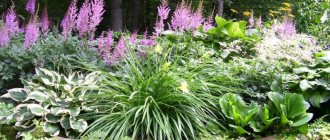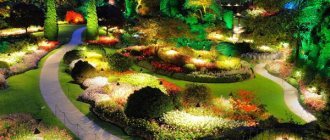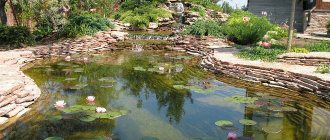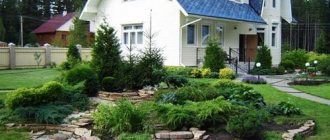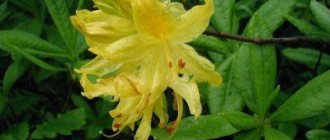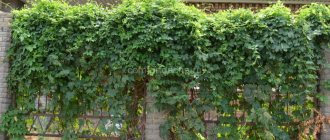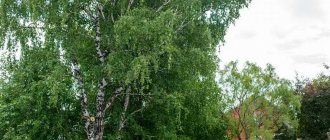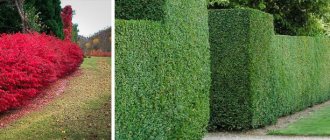Rhododendrons fully justify their status as an elite shrub. Even the difficulties in growing these plants and strict soil requirements do not prevent them from remaining one of the most beloved flowering stars. Rhododendrons are good in corners with coniferous trees and in hedges, in front gardens and flower beds, as well as as soloists and in groups. But the title of the most colorful way to use this oriental shrub in gardens is rightfully claimed by rhododendron monoflowers - a bright and easy-to-care option for growing a whole collection of varieties.
Rhododendrons in a flower garden made from a single plant feel more comfortable than in complex decorative ensembles. © Jumy jum
Features of rhododendrons in landscape design
In Japan, rhododendrons have been grown since ancient times; the Japanese consider these flowers to be a symbol of pleasure and deceit. Beautiful shrubs can be found in the landscape design of many Japanese gardens. Rhododendrons or azaleas came to Russia as a gift to the emperor in 1860.
Comment! Rhododendrons are usually called plants intended for open ground. Azaleas are small shrubs grown in greenhouses, on balconies and loggias, and indoors.
Rhododendrons are divided into 3 groups:
- deciduous;
- evergreen;
- semi-evergreen.
Deciduous shrubs shed their leaves for the winter; they grow best in the temperate climate of central Russia. Evergreens change foliage once every 2 years. Semi-evergreens shed some of their foliage in the winter and the other in the spring.
It is easy to distinguish evergreen rhododendrons in the garden landscape in the photo by their dense, leathery leaves. Interestingly, at air temperatures below 0 °C, such leaf plates curl into a tube - the bush reduces the area of moisture evaporation and remains viable until spring.
It is a rare plant in garden landscape design that has such a rich palette of colors as rhododendron. There are varieties with flowers of different shades:
- yellow;
- white;
- red;
- salmon;
- purple;
- lilac;
- pink;
- orange;
- burgundy.
Rhododendrons have a large distribution area. In Russia they are found wild in the Far East, Kamchatka, Sakhalin and Siberia. They belong to the Heather family, which also includes cranberries and blueberries.
Rhododendrons bloom very beautifully. Large bell-shaped corollas of various shades bloom like lush fireworks, hiding the foliage underneath. One brush contains several colors. There are varieties with wavy, corrugated flower petals, double or intricately curved corollas.
Description
In nature, this plant can be found in the middle and southern latitudes of the northern hemisphere. There is a huge variety of varieties of rhododendrons, they can be either deciduous or evergreen shrubs or trees, ranging in height from 0.5 m to 30 m. All of them are remarkable for their beautiful dark green foliage and especially for their magnificent flowers, which also have a wide variety of colors and shapes . Rhododenrons usually grow near bodies of water, in the foothills and mountains.
Surely many are familiar with the azalea, which can often be found in apartments as a houseplant. Azalea also belongs to the rhododendron genus. During flowering, azalea produces lush, bright flowers of various shades. Looking at an indoor azalea, it’s hard to believe that rhododendrons can be huge in size: up to 30 m high.
Rhododendrons can be either perennial or annual plants. Rhododendrons can bloom in red, purple, blue, as well as yellow or white flowers. Rhododendron blooms in spring, as soon as the weather stabilizes. The duration of flowering is the entire warm period.
Since rhododendrons love warmth, only winter-hardy varieties should be planted in mid-latitudes. These varieties include, for example
Recommendations for planting rhododendrons in the landscape
For those gardeners who love flowers but do not have a well-lit flowerbed on their site, rhododendrons will be a real boon. These shrubs grow and bloom well in the shade on the north side of the house, which is difficult to decorate with any vegetation.
In nature, rhododendrons grow in the undergrowth where there is partial shade. When planting in a garden landscape design, this must be taken into account; from 10 a.m. to 4 p.m., direct sun should not shine on the bushes. It is good to plant bushes around an artificial pond; they love coolness and moisture. Ornamental evergreens need some morning or evening sun.
Deciduous rhododendrons are less capricious and can grow in a well-lit area of the garden. Evergreen varieties do best in the shade of buildings or large trees. Plants are sensitive to care; if not cared for properly, they may not bloom for a long time.
Species rhododendrons are propagated by seeds, while hybrid varieties are propagated by cuttings or seedlings from garden centers. Plants easily tolerate transplantation at a young age. Their seeds are photosensitive; when sowing, they cannot be embedded in the soil. Photosynthesis occurs when light hits, this process helps the germination of seedlings.
Variety of species
Now there are about 70 species of juniper with numerous varieties suitable for cultivation in our conditions. Most often, the following types of juniper are considered as a new resident for the garden:
One of the unpretentious options is the Virginia juniper, which is native to North America. In nature, these are trees reaching up to 30 m in height, but in gardens decorative varieties are used that have retained the unpretentiousness and hardiness of the species: they are winter-hardy, drought-resistant, and can tolerate partial shading and soil salinity.
Red cedar
Another species from North America that is frost-resistant and resistant to adverse factors is rock juniper. Its varieties are represented by woody forms up to 10 m in height.
Common juniper, which grows in the forests of Europe, Asia, North America and on the mountain slopes of North Africa, is adapted to different conditions. They are presented in both woody and creeping forms.
Common juniper
Common juniper
The Chinese juniper by its name alone defines the area of its growth: China, Korea, Japan, the coastal region of Russia. This species is considered unpretentious, easily tolerating poor soil, drought and other unfavorable conditions. Its famous variety is the compact juniper “stricta”.
Cossack juniper, which grows in the forests of Southeast Asia, Europe, on the slopes of the Urals, Asia Minor and the Caucasus, easily fits into our conditions. Usually this is a juniper, spreading along the surface of the ground, although small trees are also found.
Juniper Cossack
A hybrid of Cossack and Chinese junipers is considered to be the medium juniper, which has the inherent resistance to unfavorable environmental conditions of its ancestors. Among its varieties, the most interesting are the golden ones: “Gold Coast” juniper and “Old Gold” juniper.
Scaly juniper, which grows in China, is also not very demanding on environmental conditions. Almost all of its varieties are suitable for decorative gardening: blue carpet, holger, and meyeri junipers. Most often, blue star juniper, shaped like a pillow, is planted on alpine hills.
As a ground cover plant for garden design, you can consider horizontal or prostrate juniper, whose homeland is considered to be North America. It has the appearance of an evergreen creeping shrub.
Juniper horizontal
Coastal juniper, which is often considered a collection plant, is considered difficult to grow in our conditions. It is a creeping shrub native to Sakhalin and Japan.
Coastal juniper
Coastal juniper
Rules for combining rhododendrons with other plants
Rhododendrons in garden landscape design grow wonderfully under pine trees and fruit trees. They do not like birch, maple and plants with a shallow root system, which will be competitors for them in the fight for water and food. It is not advisable to plant bushes on the lawn. The grass in the tree trunk circle will take away nutrients and moisture. Young shoots will not be able to develop in the shade and will die off.
The success of growing rhododendrons in the garden landscape depends on the correct substrate. It is prepared from the following components, taken in equal proportions:
- garden soil;
- rotted pine litter from under a pine tree;
- sour peat
Even better, instead of garden soil, add pine forest litter, which contains mycorrhiza. The roots of azaleas cannot obtain nutrients from the soil; the mycorrhizal fungus helps them do this.
Important! You cannot use black peat instead of red sphagnum peat. It does not have the ability to retain water; the bushes suffer from drying out roots.
Rhododendrons go well with conifers in landscape design. Low-growing shrubs are planted in the foreground in groups of 3-5 pieces. Groups are placed in accordance with the color of the flowers, avoiding bright contrasts. White inflorescences combine with any shade without creating excessive diversity in landscape design. Each individual variety blooms for two weeks.
Reproduction
The plant is propagated by dividing the bush, layering, grafting, seeds, and cuttings.
Seed propagation is an excellent method for breeding plants with better properties.
There are two good periods for seed propagation - the end of November and from the end of December to the end of the first spring month.
For this method, the following steps are performed:
- the substrate is prepared (a mixture of 1 part sand and 3 parts peat soil);
- seeds are placed, they need to be sprinkled with sand;
- covered with glass;
- the container is placed in a bright room;
- Watering is done as the soil dries.
Young sprouts are transplanted into a larger container. For the first year, young plants are kept in greenhouse conditions and then transferred to open ground. This method has its advantages, but the plants will become full-fledged in 5-6 years.
Using vegetative methods of propagation (dividing a bush, cuttings, rooting branches) you can quickly acquire new plants.
Propagation by cuttings:
- cut the stems into cuttings 5-8 cm long;
- remove leaves from the bottom of the cuttings;
- place for 12-16 hours in a substance to stimulate growth;
- plant in a peat-sand mixture, cover with polyethylene;
- cuttings are grown in peat soil (temperature about 12°C);
- In the spring they are planted and further germinated.
Conifers and rhododendrons in landscape design
Conifers are good companions for rhododendrons in landscape design. This composition looks beautiful in the spring - evergreen pines, firs, junipers alternate with bushes completely strewn with flowers. In autumn, some rhododendrons change the color of their foliage, but the conifers remain green or bluish-gray - this gives the landscape design a special charm.
Comment! Coniferous plants, like rhododendrons, love acidic soils and feed on mycorrhizae, so such a neighborhood is not only beautiful, but also profitable.
Deciduous species have a bright, fiery range of inflorescence colors - orange, lemon, yellow. Evergreen varieties most often have white, purple, pink, and burgundy flowers. They can be successfully combined in a single garden landscape design composition, thanks to the contrast of cold and warm colors. In autumn, evergreen rhododendrons remain with green leaves, while deciduous rhododendrons change color to red, orange or yellow. It also looks very beautiful against the backdrop of evergreen pines or spruces.
It is advisable for a novice gardener to buy seedlings of species of rhododendrons, which are easy to care for. Having gained experience, you can move on to evergreen species and varieties. Rhododendron from the Finnish selection of the University of Helsinki has good frost resistance.
How to determine which rhododendron grows on the site?
Now you're the proud owner of your own rhododendron - how do you know what species or variety you have?
Firstly, all varieties can be classified according to the color of the petals: yellow ones are Klondike, Narcissiflora, Anneke and other hybrids; Ghent hybrids differ in color; pink - Homebush and red - Nabucco, Kamchatka and other sub-variants.
There are quite a few varieties of this plant, and they all have bright colors.
Distinctive features
First of all, deciduous rhododendron has excellent cold resistance - therefore, some varieties tolerate only warm climates well or require additional insulation from frost.
Landscape tricks with rhododendrons in the garden
There is no particular difference in care between deciduous and evergreen rhododendrons. Only a planting location in the garden landscape design for deciduous varieties can be chosen that is more sunny. These ornamental shrubs tolerate heat and cold well and do not grow only on alkaline and neutral soils. And also in areas where irrigation water contains a lot of lime. It is best to use rain or spring water for irrigation.
There are many beautiful species of rhododendrons and cultivars, zoned for landscape design in certain regions. They differ not only in the color of the flowers, but also in the flowering period. For example, Daurian rhododendron blooms early, in early May. By planting several varieties with different flowering periods, you can observe this miracle in your garden for a month and a half. And the Pontic rhododendron is one of the most winter-hardy, and its other advantage is the wonderful aroma of blooming flowers.
Rhododendrons and conifers not only go well together in garden landscape design, but also have common care requirements. They do not like rotted manure and sawdust. Limestones, which reduce the acidity of the soil, should not be used to decorate the tree trunks of plants. It is advisable to check this indicator using a special device - an acid meter. The soil eventually becomes neutral, like the rest of the garden, and needs to be acidified.
Advice! As an acidifier, you can use a solution of ordinary electrolyte (1 tsp per 10 liters of water). Bushes are watered with this mixture once a year. You will have to acidify the soil more often with a solution of acetic acid.
The hardest time for azaleas is February-March. If evergreen bushes are exposed to direct sunlight most of the day, the flower buds and leaves may become scorched. To prevent this from happening, the plants need to be shaded and watered with warm water at the roots. Feeding once every 2-3 years will help improve the decorative properties of rhododendrons in landscape design. If you apply them sparingly, the bushes will produce less growth, begin to branch better and bloom more luxuriantly.
I'm not keen on fertilizers
Properly prepared soil will last for many years for the full development of rhododendrons. In the future, I add a little urea in the spring and acidify the irrigation water with citric acid a couple of times a season. I prepare the solution based on the proportion - 3 teaspoons per 10-liter watering can. I often don’t use fertilizers; I think it’s more useful to make an infusion based on manure (cow or horse) and water the bushes with it throughout the season. I distribute the remaining manure in the form of cake on top of the roots. In the fall, to insulate the roots for the winter, I first add leaf humus, and put a little sour peat on top. But you still shouldn’t get carried away with this, since rhododendrons have a tendency to grow their roots upward (like spruce trees) if there is a substrate where they can grow. Over time, you may end up with an undesirable raised area on the roots that prevents the roots from draining well as the water runs off.
